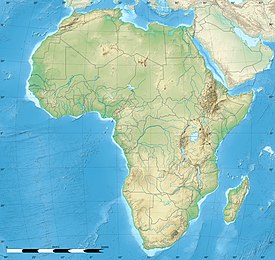| Porc-Epic Cave | |
|---|---|
| Coordinates | 9°34′17″N 41°53′15″E / 9.5715°N 41.8874°E |
Porc-Epic Cave is an archaeological site located in Dire Dawa, Ethiopia. Dated back to the Middle Stone Age, the site contains extensive evidence of microlithic tools, bone and faunal remains. The lithic assemblage reveals that inhabitants at the time were well-organized with their environment. Pointed tools indicate that the cave served as a hunting camp during seasons that game was plentiful.[1] There is also strong evidence of ochre processing and rock art. The site was first discovered in 1920 by H. De Monfreid and P. Teilhard De Chardin. H. Breuil and P. Wernert performed the first excavation in 1933, followed from 1975 to 1976 by J. Desmond Clark and K.D. Williamson. Succeeding this was an excavation in 1998.[2] Porc-Epic Cave provides insight into the behavior and technical capability of modern humans in East Africa during the Middle Stone Age.
History
editExcavations 1933-1998
editH. Breuil and P. Wernet undertook the first excavation in 1933 and largely focused on the entrance of the cave. Throughout this excavation, there was an abundance of obsidian and basalt artifacts. A human jaw fragment was also uncovered and described as having both neanderthal and non-neanderthal features.[1] Throughout 1975 to 1976 most of the cave was excavated by J. Desmond Clark and K.D. Williamson. A collection of stone tools were recovered and accounted for over 90% of the total material extracted from the cave. Thousands of faunal artifacts were successfully excavated as well.[3] In 1998, a collaborative project took place between the French MNHN and Authority for Research and Conservation of Cultural Heritage (ARCCH) of Ethiopia concerning fieldwork on the site.[2]
Significance
editArchaeological Evidence
editRock Art
editOchre processing is the grinding and flaking of ochre that results in fine-grain and powder.[4] The brownish-yellow or red pigment that was produced is often used in prehistoric artwork. Rock art has been identified on the cave walls and studies reveal that the art is "older than the formation of the most recent stalagmite of the archaeological levels.” [5]
References
edit- ^ a b Clark, J. Desmond; Williamson, Kenneth D.; Michels, Joseph W.; Marean, Curtis A. (1984-12-01). "A Middle Stone Age occupation site at Porc Epic Cave, Dire Dawa (east-central Ethiopia)". African Archaeological Review. 2 (1): 37–71. doi:10.1007/BF01117225. ISSN 1572-9842.
- ^ a b Pleurdeau, David (2005-12-01). "Human Technical Behavior in the African Middle Stone Age: The Lithic Assemblage of Porc-Epic Cave (Dire Dawa, Ethiopia)". African Archaeological Review. 22 (4): 177–197. doi:10.1007/s10437-006-9000-7. ISSN 1572-9842.
- ^ Pleurdeau, David (2005-10-25). "THE LITHIC ASSEMBLAGE OF THE 1975-1976 EXCAVATION OF THE PORC-EPIC CAVE, DIRE-DAWA, ETHIOPIA - IMPLICATIONS FOR THE EAST AFRICAN MIDDLE STONE AGE". Journal of African Archaeology. 3 (1): 117–126. doi:10.3213/1612-1651-10040. ISSN 1612-1651.
- ^ Rosso, Daniela Eugenia; d’Errico, Francesco; Queffelec, Alain (2017-05-24). "Patterns of change and continuity in ochre use during the late Middle Stone Age of the Horn of Africa: The Porc-Epic Cave record". PLOS ONE. 12 (5): e0177298. doi:10.1371/journal.pone.0177298. ISSN 1932-6203.
{{cite journal}}: CS1 maint: unflagged free DOI (link) - ^ Rosso, Daniela Eugenia; d'Errico, Francesco; Zilhão, João (2014-09-01). "Stratigraphic and spatial distribution of ochre and ochre processing tools at Porc-Epic Cave, Dire Dawa, Ethiopia". Quaternary International. Changing Environments and Movements through Transitions: Paleoanthropological and Prehistorical Research in Ethiopia A Tribute to Prof. Mohammed Umer. 343: 85–99. doi:10.1016/j.quaint.2013.10.019. ISSN 1040-6182.
